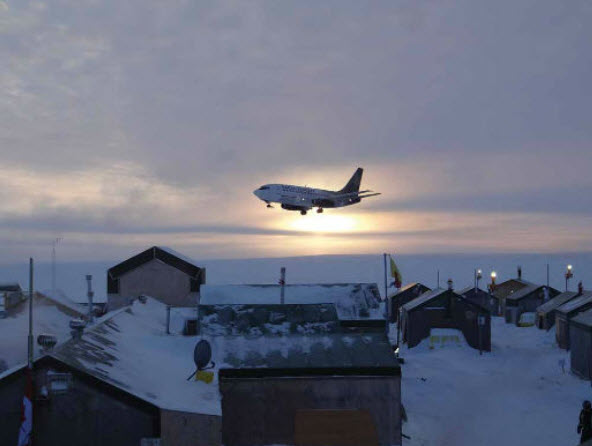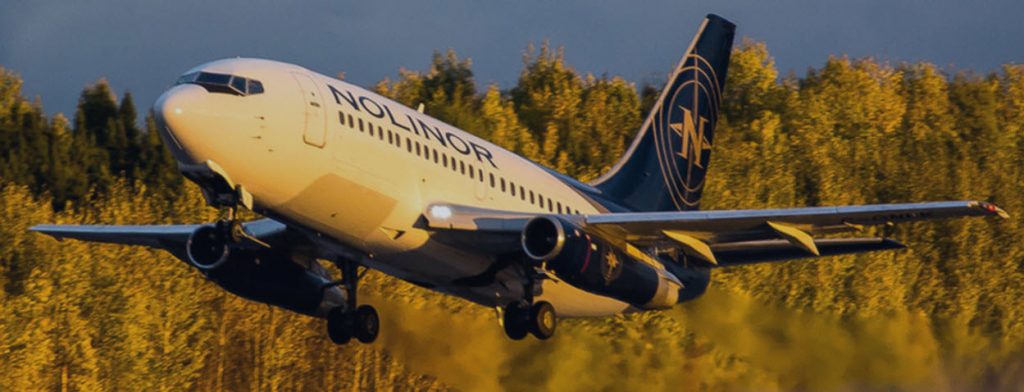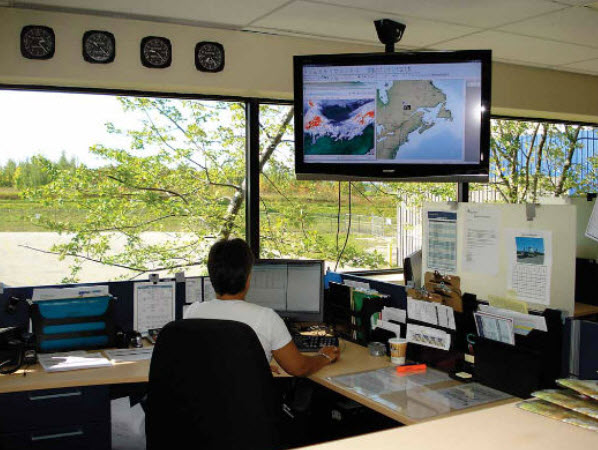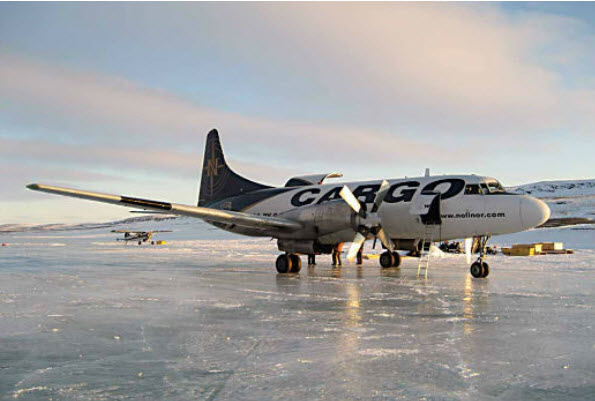Written for Skies Magazine – March/April 2015
“How did Nolinor get its name? Everybody asks that,” laughed Dave Morgan, Nolinor Aviation’s director of sales and marketing. “It was in the early days of the company, and the partners decided to combine the French word ‘nolise,’ which means ‘to charter,’ with the word ‘north.’ They couldn’t decide whether to use the French ‘nord’ or the English word, so they compromised and chopped some letters. So, we’re Nolinor,” explained Morgan.
No matter the derivation, Nolinor Aviation has grown from humble roots into one of the largest cargo, combi and passenger charter airlines in Canada.
“It all started in the early 1990s with some business owners who couldn’t get the service they wanted into their hunting and fishing camps,” said Morgan. The group acquired a twin-turboprop Convair 580, and began service from Dorval to Schefferville, Que., close to the Labrador border. Nolinor president Jacques Prud’homme became a shareholder and joined the company in 1999. Eventually, the Prud’homme family became the sole owner of the airline.
“Our main clients are northern resource-based, in the mining and exploration sector,” said Morgan. “We have government, defence, and Coast Guard crew change [contracts], and we recently became involved with Arctic cruise lines, moving passenger traffic up to their vessels in the North through the summer.”
The airline flies all over Canada, the United States and Mexico. It recently completed a three-year contract in Africa, and has operated to Europe. Nolinor operates a total of 10 aircraft and has bases across Canada, each configured to meet clients’ needs. For example, the airline’s base at Kitchener/Waterloo Airport (YKF) has been in operation since September 2013.
“We work with a mining company, and we provide them with 737 passenger, cargo and combi service,” said Morgan. “It’s a planned schedule, with a number of flights per week that fly first to Iqaluit, and then to the mine site further north. The trip length is like flying from YKF to Mexico!”
Nolinor’s YKF base includes crew quarters, maintenance equipment, a contracted cargo facility and leased hangar space, with 20 people supporting the operation. Morgan estimated that 70 per cent of Nolinor’s charters serve the resource sector, but noted that “we haven’t strayed too far from our roots, because we still fly to hunting and fishing camps all across the country, with the Convairs.”
Nolinor now has five 580s in the fleet: three in passenger configuration and two all-cargo. With the Convairs being of a vintage that would qualify them for Old Age Security benefits, one might think that maintaining the aircraft in an airworthy condition would be a challenge. Not so, said Serge Bernier, Nolinor’s logistic and security manager. “It’s a very reliable machine; it’s easy to maintain, but it needs a lot of love. We put the love into it, because safety is first to us,” he said.
Responding to its customers’ needs, Nolinor added two Boeing 737-200s in 2007, followed by another in 2011, and a fourth in 2014. The 737 fleet is a mix of cargo and combi aircraft, which can be configured to include between two and six cargo containers, along with 11 to 77 passengers. In full passenger mode, the combi has 119 seats. Although the planes are over 30 years old, the 737-200s are uniquely suited to northern operations, with the capability to operate from short runways, gravel strips and ice runways. “We’ve gone all over the world to find the gravel kits and the pieces that we need to operate these machines, and to know that we can operate them for the long term,” said Morgan.
And there’s still lots of life in the 737s. “Running them at maximum utilization, there’s 20 years left. When we look for a new 737-200, it has to have at least 25,000 hours of life left, because of the investment we make in upgrades, and to bring the airplane up to our standards,” continued Morgan. “The 737s and the 580s weren’t bought because they were older or they were cheaper. They were bought to fill a specific need, and because they could land on short, gravel strips in Northern Canada,” he added.
Nolinor has made a substantial investment in on-board avionics and safety equipment, including Kelowna, B.C.-based SkyTrac’s real-time, in-flight data and voice connectivity system. “We couldn’t be more satisfied with the technology,” said Morgan. “It will tell us if we have an in-flight issue, and people can start planning before the pilots even have time to give us a call. To do that, all the pilot has to do is press a button on the comm panel, and he’s live with our operations centre. When we send out charters, we can track the planes and see exactly where they’re taxiing, and even if the pilots are at the right FBO.”
The pilots flying for Nolinor reflect the passion for aviation that runs throughout the airline. “We hire very experienced captains. We have guys flying 737-200s who have been flying 747s. They’re the sort of pilots who have had a long career, who have good hands and feet, and have the passion and want to keep flying. They mentor the young pilots in the right seat, and teach them the do’s and don’ts of the real world. And they love it when they come to work because we do something different every day,” explained Morgan.
Added Bernier: “A friend of mine flies the Airbus A340 all around the world. He came to see our facilities, the Convairs and the 737s, and he was in heaven. He said, ‘One day, I wish I could come back and fly these machines!’”
Morgan noted that the biggest challenge of airline operations in the North is dealing with the logistics of being 2,000 miles from base. “It’s turning the North into your home, and having the proper equipment in place to get you out of a bind, and to get the airplane on its way back home.”
He explained that the airline will bring in the required infrastructure to support a customer’s operations, to enhance safety and mitigate risk. “If we need to have a WAAS (Wide Area Augmentation System) approach installed for a gravel—or even an ice—runway, we do it. We’ve run approaches into an ice runway that have minimums similar to what you have at (Toronto) Pearson,” said Morgan.

A Nolinor Boeing 737-200C, landing in the twilight at a remote Northern exploration site. Photo: Nolinor
To operate the 737s from an ice runway, the ice must be at least 120 centimetres thick. To give an added measure of safety, Nolinor has every potential ice runway inspected with ground penetrating radar. “You know that these mining companies are the best risk managers in the world, so when we sit down across the table from them, we have to be at their level. We have to be prepared to be audited to the highest standards,” said Morgan.
Nolinor was the first jet operator in the world to utilize the Bulk Aviation Transportation Tank (BATT), an award-winning, collapsible, in-cabin fuel tank, developed by Delta, B.C.-based SEI Industries. “That piece of equipment is incredible,” said Morgan. “We can install it in a combi 737 in the matter of an hour, fill it up with fuel, deliver it to a client’s site, and then offload the fuel in just 10 or 12 minutes. But the best part about the whole system, [is that] we can fly back into town, take the tanks out and put the seats back into the plane without passing a mop. You can’t smell a thing.”
The BATT fills up three-quarters of the 737’s cabin, and carries 10,000 kilograms of fuel. Even with that capacity, Nolinor will fly repeated trips to a customer’s site. “We’ve done 150 fuel flights onto frozen lakes to replenish a client’s fuel supply. An advanced exploration project can burn through millions of litres of fuel a year just to power generators, and that’s without a single truck. And, we’ve got a couple of weeks to get it done when the lake is frozen and the weather is clear,” said Morgan.
At its Mirabel, Que., base, Nolinor often hosts aviation enthusiasts from around the world, who want to fly on the airline’s venerable Convair 580s. “Those guys are crazy about that,” chuckled Bernier. “They know technical stuff about the plane that even we don’t know!”
But the Convair’s days are numbered. Morgan explained that the 580s are coming to the end of their life cycle, and that Nolinor isn’t planning to convert the planes to Kelowna Flightcraft’s “stretch” Convair 5800 version.
Morgan said that Nolinor has talked to operators of the twin-turboprop ATR 42 and 72, evaluating them as possible replacements for the 580. “You don’t want to be a leader in the difficult operating environment of the North. You want to follow what other people are doing, and there are a couple of [ATR] operators that are doing OK with that equipment, that have spent a lot of time figuring out how to do it,” he said.
“But we’ve flown executive charters on the 737-200,” added Morgan. “If you have a nice glass of champagne and the airplane is first class from nose to tail, well, we’re all about the service we can provide, and what the client wants. And that’s the key to the culture of this company.”
Morgan said that Nolinor has flown charters where four flight attendants served a VIP group of only 35 passengers; another flight to Finland and back for a mining company and northern community leaders, with six in-flight services during the trip, all served on fine china; and flights for professional sports teams, where the exterior and the interior of the plane are branded with the team’s logo.
Morgan believes that one of Nolinor’s advantages in the marketplace is the airline’s small size, adaptability, and responsiveness to client needs.
“There’s no giant corporate structure, where we’re sitting around spending days in a board room discussing key performance indicators [KPIs],” he said. “Our KPI is getting out there, shaking a customer’s hand, and knowing that the job got done. Our president, Mr. Prud’homme, is also an experienced pilot, and he passes out his cell phone number to our clients. If you need to call Nolinor, and the salesperson isn’t available, you can call the president and he’ll answer.”
Everyone at Nolinor has a hand in the day-to-day operations of the airline, explained Morgan. “They call me the director of sales and marketing, but I could be jumping on a plane to supervise the loading of a heavy piece of cargo in Chicago, heading down to Miami for a flight coming in, or going to Mexico to pick up a load of auto parts—and me and the director of commercial operations have jumped on the plane to load it.”
Bernier also noted that being a “pure charter” operation is an advantage that some of Nolinor’s competitors can’t match. “We don’t have to adapt a scheduled passenger service to our customers’ needs, say, by having to make sure that a 737 is back at base on Sunday night to fly a scheduled passenger flight on Monday morning. Wherever and whenever our customers want to go, we can do it,” he said.
And what’s in store for Nolinor? “It sounds crazy, but we’re literally going to react to the market. We’re a family-owned, private company, and if a client comes in tomorrow and says, ‘We need three 580s or four Antonovs,’ we can react to that and anything in between,” said Morgan.
“We’re an ever-evolving company, and we’re a bunch of hard-core airplane geeks who are liable to go in several directions at once. And when the owner of your airline has changed the engine on a [Noorduyn] Norseman with three logs and some rope on a lake with the mosquitos, he understands everything he needs to know about aviation. So, we’ll look to the Prud’homme family for the guidance to steer the airline in the future.”
But wouldn’t an Antonov An-124, flying out of Mirabel in Nolinor colours, be awesome?!


